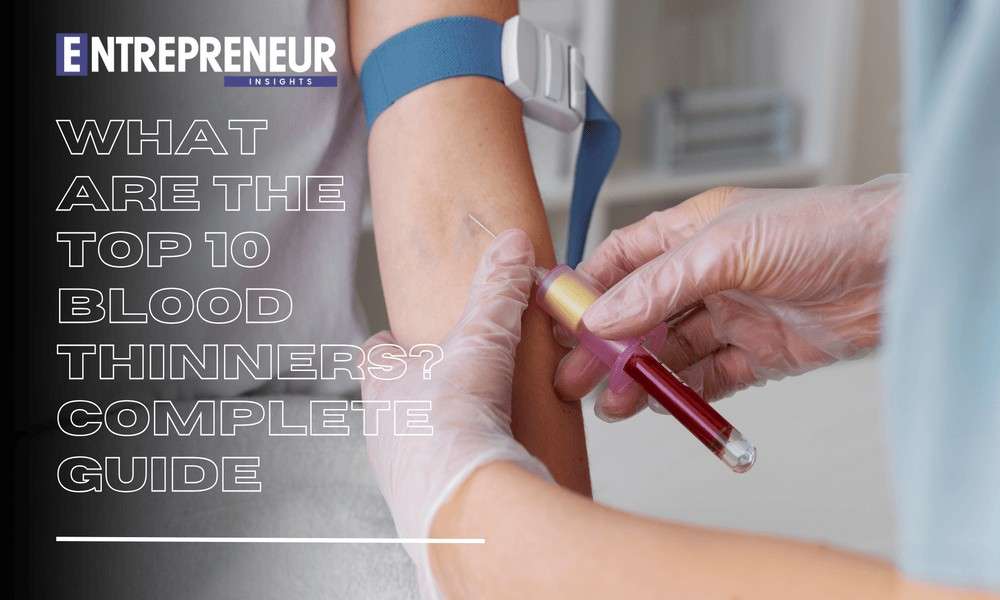Blood thinners, also known as anticoagulants and antiplatelet drugs, are essential for protecting your heart and preventing life-threatening clots. These medications lower the risk of stroke, heart attack, deep vein thrombosis (DVT), and pulmonary embolism (PE) by preventing blood clots from forming or growing. Furthermore, when used correctly, they contribute to long-term cardiovascular health.
In this Entrepreneur Insights guide, we will explore the top 10 blood thinners, their uses, side effects, and what makes each one effective.
1. Warfarin (Coumadin) – The Classic Blood Thinner
Warfarin is one of the oldest and most reliable anticoagulants. It works by inhibiting the liver’s use of vitamin K, which is required for clotting. As a result, it aids in preventing clot formation in a variety of situations.
Uses: Stroke prevention, atrial fibrillation, DVT, PE
Monitoring: Requires regular INR testing
Interactions: Many foods and medications, especially vitamin K-rich foods
Side Effects: Bleeding, bruising, dietary limitations
Despite being older, Warfarin remains a reliable and affordable option.
2. Apixaban (Eliquis) – The Modern Anticoagulant
Apixaban (Eliquis) is a direct oral anticoagulant (DOAC) that prevents blood clots by inhibiting Factor Xa, a key clotting factor. Apixaban, unlike Warfarin, does not require regular blood tests.
Uses: Stroke prevention, DVT, and PE treatment
Advantages: No routine blood tests, fewer food interactions, predictable dosing
Side Effects: Bleeding, anemia, nausea
Therefore, Apixaban is preferred for its convenience and safety profile.
3. Rivaroxaban (Xarelto) – Once-Daily Convenience
Rivaroxaban (Xarelto) is another Factor Xa inhibitor that is known for its once-daily dosing. Because of its ease of use, it’s often prescribed to patients who require long-term anticoagulation therapy.
Uses: DVT, PE, and stroke prevention in atrial fibrillation
Advantages: No INR monitoring required
Side Effects: Increased risk of gastrointestinal bleeding
Thus, Rivaroxaban is an excellent choice for many patients.
4. Dabigatran (Pradaxa) – Direct Thrombin Blocker
Dabigatran (Pradaxa) works by directly blocking thrombin, an enzyme responsible for clot formation. This mechanism sets it apart from other anticoagulants, offering a different approach to preventing blood clots.
Uses: Stroke prevention in atrial fibrillation, DVT, and PE treatment
Advantages: Predictable effects, fewer interactions
Reversal Agent: Idarucizumab (Praxbind) is available for emergency reversal
Side Effects: Heartburn, indigestion, bleeding
Moreover, Dabigatran provides a reversal agent, which can be critical in emergency situations.
5. Edoxaban (Savaysa) – New-Generation DOAC
Edoxaban (Savaysa) is a Factor Xa inhibitor that offers effective clot prevention with minimal monitoring requirements. Like other DOACs, it simplifies treatment and improves patient compliance.
Uses: Non-valvular atrial fibrillation, DVT, and PE after initial heparin therapy
Advantages: Once-daily dose, fewer side effects
Caution: Not suitable for patients with high kidney function
Therefore, Edoxaban is a safe and effective choice for many patients.
6. Heparin – The Hospital Essential
Heparin is a fast-acting injectable anticoagulant that is widely used in hospitals. It works by increasing the activity of antithrombin III, which deactivates clotting factors and thus prevents clot formation.
Uses: Emergency treatment of DVT, PE, and prevention during surgeries
Forms: Unfractionated heparin (UFH) and low molecular weight heparin (LMWH)
Side Effects: Bleeding, heparin-induced thrombocytopenia (HIT)
As a result, Heparin remains indispensable in critical care and surgical settings.
7. Enoxaparin (Lovenox) – Low Molecular Weight Heparin
Enoxaparin (Lovenox) is a low molecular weight heparin (LMWH) that offers more predictable results than traditional heparin. In addition, it is more convenient for patients due to less frequent dosing.
Uses: DVT prevention post-surgery, PE treatment, unstable angina management
Administration: Subcutaneous injection
Advantages: Longer duration, less frequent dosing
Side Effects: Bleeding, pain at the injection site
Consequently, Lovenox provides reliable anticoagulation both in hospitals and for outpatient care.
8. Clopidogrel (Plavix) – Antiplatelet Leader
Clopidogrel (Plavix) is an antiplatelet medication that reduces the risk of arterial clots. Unlike anticoagulants, it works by preventing platelets from clumping together.
Uses: Heart attack prevention, stroke prevention, post-stent therapy
Mechanism: Blocks ADP receptors on platelets
Advantages: Works well with aspirin
Side Effects: Bleeding, bruising, rare allergic reactions
Therefore, Clopidogrel is widely prescribed for cardiovascular protection.
9. Aspirin – The Everyday Protector
Aspirin (ASA) is a widely used, affordable antiplatelet drug that helps prevent clots. It is often recommended for people at high risk of heart attacks or strokes.
Uses: Heart attack and stroke prevention, blood clot prevention in high-risk individuals
Mechanism: Inhibits the COX-1 enzyme, preventing platelet clumping
Advantages: Low cost, proven benefits
Side Effects: Stomach irritation, bleeding, ulcers with long-term use
In conclusion, Aspirin remains a staple in cardiovascular protection, especially for secondary prevention.
10. Ticagrelor (Brilinta) – Fast-Acting Platelet Blocker
Ticagrelor (Brilinta) rapidly inhibits platelet aggregation, making it effective for managing acute coronary syndrome and post-stent care. In addition, it offers superior protection for patients with high cardiac risk.
Uses: Acute coronary syndrome management, post-stent care
Mechanism: Blocks P2Y12 receptors on platelets
Advantages: Fast onset, potent protection
Side Effects: Shortness of breath, bleeding, dizziness
Thus, Ticagrelor is a strong choice for high-risk cardiac patients requiring aggressive therapy.
Choosing the Right Blood Thinner
The best blood thinner for you is determined by a number of factors, including your medical history, kidney function, age, bleeding risk, and current medications. Your doctor will consider these factors before recommending the appropriate medication.
Patients should never start or stop anticoagulants without consulting a healthcare provider. Otherwise, sudden changes in blood thinners can lead to serious complications, such as stroke or internal bleeding.
Final Thoughts
Understanding the top ten blood thinners allows you to make more informed healthcare decisions. From Warfarin to modern DOACs such as Eliquis and Xarelto, each option provides distinct advantages. Furthermore, as blood thinners evolve, they become safer and more manageable.















Leave a comment